Your cart is currently empty!
Tag: Data Center Reactive Maintenance

The Cost of Downtime: How Data Center Reactive Maintenance Can Minimize Risks
Data centers are the backbone of the modern digital world, housing the servers and equipment that power everything from small businesses to large corporations. However, like any complex system, data centers are not immune to problems and downtime. In fact, downtime can be incredibly costly for businesses, both in terms of lost revenue and damage to their reputation.The cost of downtime can vary greatly depending on the size and nature of the business, but it can easily run into the thousands or even millions of dollars per hour. In addition to the immediate financial impact, downtime can also have long-term consequences, such as lost customers and damage to a company’s brand.
One way to minimize the risks of downtime is through proactive maintenance of data center equipment. By regularly inspecting and maintaining equipment, businesses can identify and address potential issues before they escalate into major problems. This proactive approach can help prevent unexpected outages and keep systems running smoothly.
However, even with proactive maintenance, it’s impossible to completely eliminate the risk of downtime. That’s where reactive maintenance comes in. Reactive maintenance involves responding to issues as they arise, rather than proactively addressing them. While reactive maintenance is not ideal, it can be a necessary part of a comprehensive maintenance strategy.
The key to effective reactive maintenance is to respond quickly and efficiently to issues. This requires having a team of skilled technicians on hand who can quickly diagnose and address problems. It also requires having access to spare parts and equipment, so that repairs can be made as quickly as possible.
While reactive maintenance can help minimize the risks of downtime, it’s not a perfect solution. It can be costly, both in terms of the actual repairs and the lost revenue from downtime. That’s why businesses should strive to strike a balance between proactive and reactive maintenance, ensuring that they are properly prepared for any eventuality.
In conclusion, the cost of downtime can be significant for businesses, both financially and in terms of reputation. By implementing a comprehensive maintenance strategy that includes both proactive and reactive maintenance, businesses can minimize the risks of downtime and keep their data centers running smoothly. This can help ensure that they are able to meet the demands of their customers and maintain a competitive edge in the digital world.
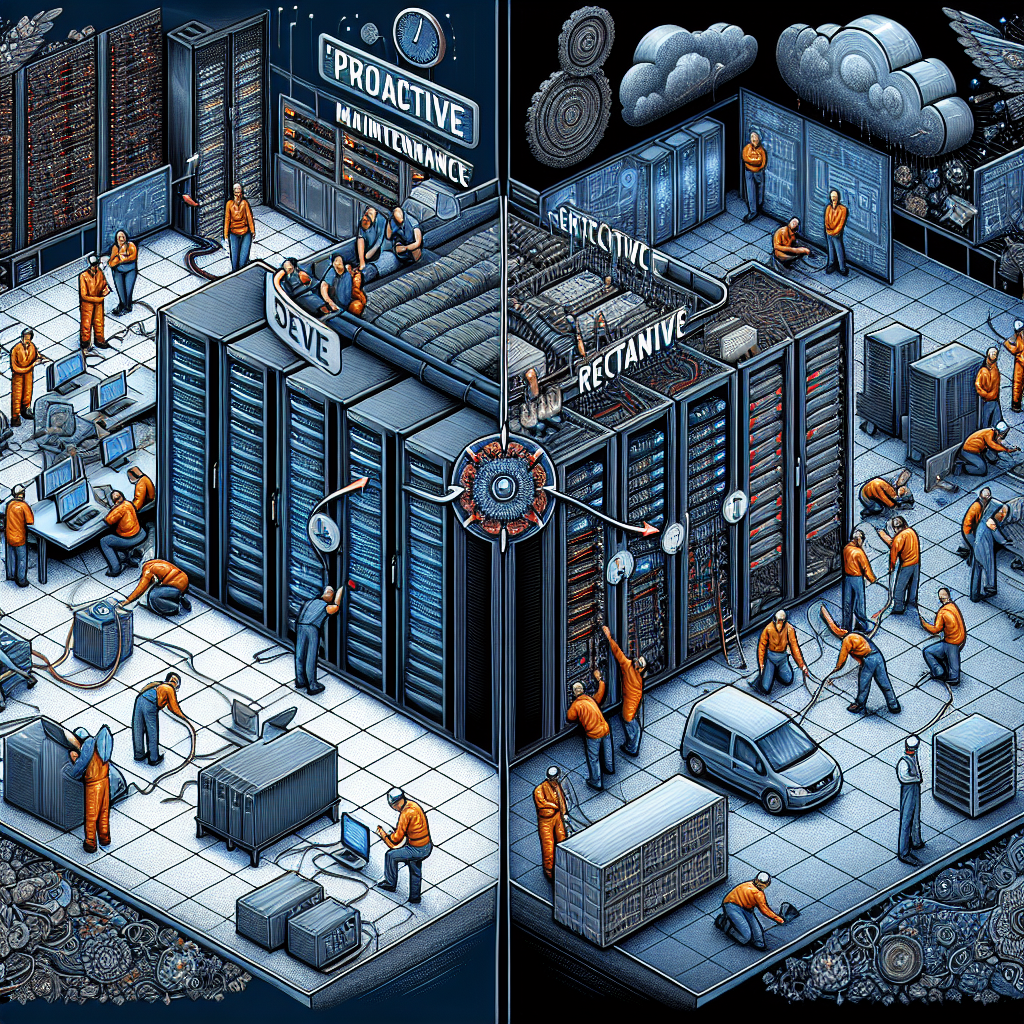
Proactive vs. Reactive Maintenance in Data Centers: Why Both Are Essential
Data centers are the backbone of modern businesses, housing the critical infrastructure that supports the digital operations of companies around the world. With the ever-increasing reliance on technology for everyday operations, ensuring the smooth functioning of data centers is more important than ever. One key aspect of maintaining data center operations is the approach to maintenance – proactive vs. reactive.Proactive maintenance involves regularly scheduled inspections, tests, and maintenance tasks to prevent equipment failures before they occur. This approach aims to identify and address potential issues before they escalate into major problems that can disrupt operations and lead to costly downtime. By implementing proactive maintenance strategies, data center operators can minimize the risk of unexpected equipment failures and ensure the reliable performance of their infrastructure.
On the other hand, reactive maintenance involves responding to equipment failures and issues as they occur. While reactive maintenance can address immediate problems and get systems back up and running quickly, it is often more costly and time-consuming than proactive maintenance. Additionally, relying solely on reactive maintenance can lead to a higher risk of equipment failures and downtime, as issues may go undetected until they cause major disruptions.
Both proactive and reactive maintenance have their own advantages and drawbacks, and data center operators must strike a balance between the two approaches to ensure the optimal performance of their infrastructure. While proactive maintenance helps to prevent issues from occurring in the first place, reactive maintenance plays a crucial role in addressing unforeseen problems and minimizing downtime when issues do arise.
In today’s fast-paced and highly competitive business environment, data centers must be able to operate at peak efficiency and reliability. By combining proactive and reactive maintenance strategies, data center operators can ensure the continuous operation of their infrastructure and minimize the risk of costly downtime. Proactive maintenance helps to identify and address potential issues before they escalate, while reactive maintenance enables quick responses to unexpected problems, ensuring that data center operations remain uninterrupted.
Ultimately, both proactive and reactive maintenance are essential components of a comprehensive maintenance strategy for data centers. By implementing a balanced approach that incorporates both proactive and reactive maintenance, data center operators can maximize the performance and reliability of their infrastructure, ultimately contributing to the success of their business operations.
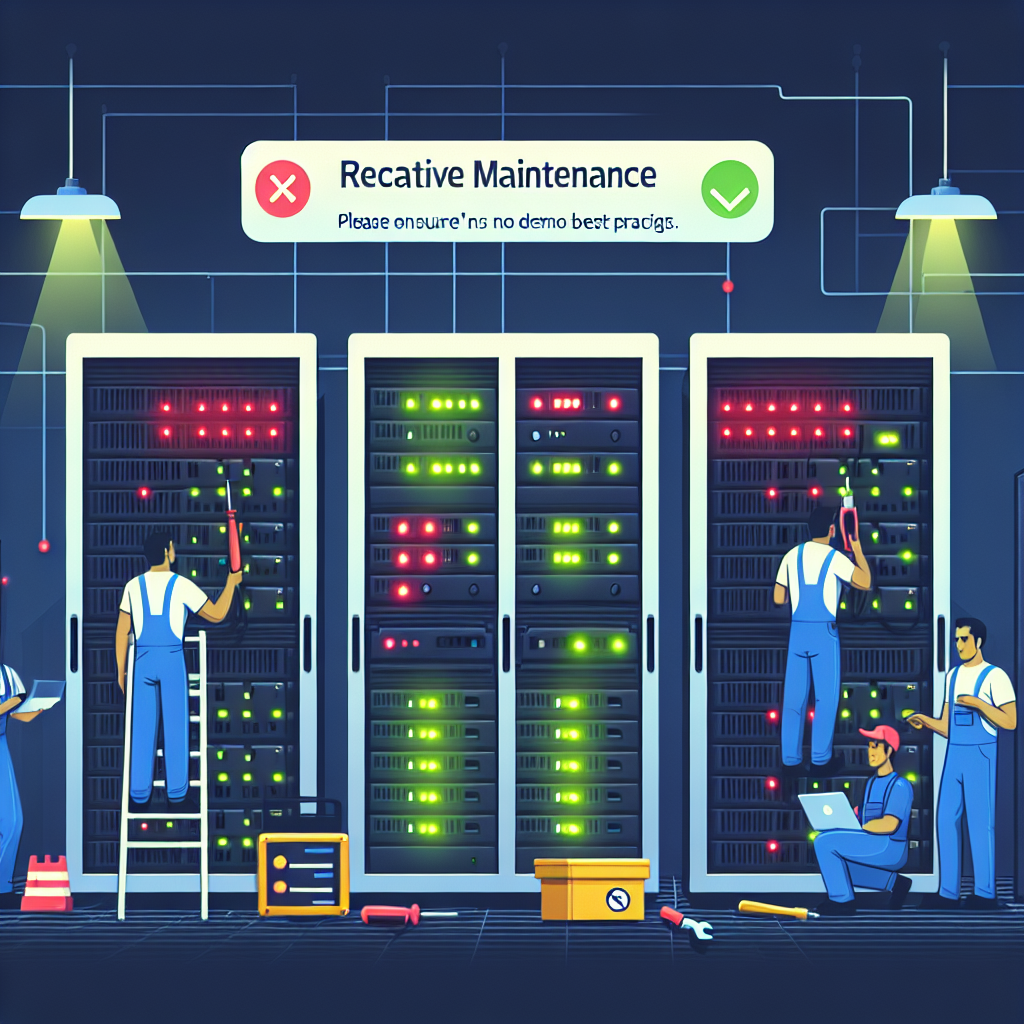
The Role of Reactive Maintenance in Data Center Operations: Best Practices for Success
Data centers are the backbone of today’s digital world, serving as the hub for all critical IT operations and ensuring the smooth functioning of businesses. With the increasing reliance on technology, the need for data centers to be up and running at all times has become more crucial than ever. This is where reactive maintenance plays a key role in ensuring the continuous operation of data centers.Reactive maintenance, also known as breakdown maintenance or corrective maintenance, refers to the repair or replacement of equipment or systems after they have broken down or failed. While proactive maintenance strategies such as preventive and predictive maintenance are essential for preventing equipment failures and minimizing downtime, reactive maintenance is equally important in addressing unexpected issues that may arise in a data center.
In data center operations, reactive maintenance is often used in conjunction with proactive maintenance strategies to ensure that all equipment and systems are functioning at their optimal levels. While proactive maintenance helps in identifying and addressing potential issues before they escalate into major problems, reactive maintenance is crucial for addressing immediate issues and ensuring minimal disruption to operations.
To ensure the success of reactive maintenance in data center operations, it is important to follow best practices that can help streamline the process and minimize downtime. Here are some best practices for success in implementing reactive maintenance in data centers:
1. Establish a robust monitoring and alert system: Implementing a comprehensive monitoring and alert system can help in detecting issues in real-time and alerting the maintenance team to take immediate action. This can help in addressing issues before they escalate into major problems and minimize downtime.
2. Prioritize critical equipment: In a data center, not all equipment is of equal importance. It is essential to prioritize critical equipment that is vital for the smooth functioning of the data center and ensure that they receive prompt attention in case of a breakdown.
3. Develop a well-defined maintenance plan: Having a well-defined maintenance plan that outlines the procedures for addressing reactive maintenance issues can help in streamlining the process and ensuring that all issues are addressed in a timely manner.
4. Implement a robust ticketing system: Implementing a ticketing system can help in tracking and managing reactive maintenance requests efficiently. This can help in prioritizing requests, assigning tasks to the maintenance team, and tracking the status of each request.
5. Conduct regular training for maintenance staff: Providing regular training for maintenance staff on troubleshooting techniques, equipment maintenance, and safety protocols can help in enhancing their skills and ensuring that they are well-prepared to handle reactive maintenance issues effectively.
In conclusion, reactive maintenance plays a crucial role in data center operations by addressing immediate issues and ensuring minimal disruption to operations. By following best practices such as establishing a monitoring and alert system, prioritizing critical equipment, developing a maintenance plan, implementing a ticketing system, and conducting regular training for maintenance staff, data center operators can ensure the success of reactive maintenance in maintaining the smooth functioning of their data centers.

The Importance of Data Center Reactive Maintenance: Tips for Keeping Your Facility Running Smoothly
Data centers are the backbone of modern businesses, providing essential services like data storage, processing, and networking. To ensure these facilities operate efficiently and effectively, it is crucial to prioritize proactive maintenance and regular inspections. However, reactive maintenance also plays a vital role in keeping a data center running smoothly.Reactive maintenance refers to addressing issues as they arise, rather than proactively preventing them. While proactive maintenance is essential for preventing downtime and ensuring optimal performance, reactive maintenance is equally important for responding to unexpected issues quickly and effectively. Here are some tips for implementing effective reactive maintenance in your data center:
1. Regularly monitor and analyze performance metrics: Monitoring key performance indicators (KPIs) like temperature, humidity, power usage, and network traffic can help identify potential issues before they escalate. By analyzing these metrics regularly, data center operators can anticipate problems and take proactive measures to address them.
2. Implement a robust incident response plan: In the event of an unexpected issue, having a well-defined incident response plan in place is crucial. This plan should outline the steps to take when an incident occurs, including who to contact, how to troubleshoot the issue, and what procedures to follow to resolve it quickly.
3. Prioritize safety and security: When responding to maintenance issues, it is essential to prioritize the safety and security of personnel and equipment. Ensure that all maintenance tasks are carried out by trained professionals following proper safety protocols and guidelines.
4. Document and learn from past incidents: Keeping detailed records of past maintenance incidents can help data center operators identify patterns and recurring issues. By analyzing past incidents, operators can learn from their mistakes and implement preventive measures to avoid similar issues in the future.
5. Partner with reliable maintenance providers: Working with experienced and reliable maintenance providers can help ensure that reactive maintenance tasks are carried out efficiently and effectively. Choose providers with a proven track record of responding quickly to emergencies and resolving issues promptly.
In conclusion, while proactive maintenance is essential for preventing downtime and maximizing the efficiency of a data center, reactive maintenance is equally important for addressing unexpected issues and keeping the facility running smoothly. By implementing the tips mentioned above and prioritizing safety, security, and collaboration with maintenance providers, data center operators can ensure that their facilities remain operational and reliable.
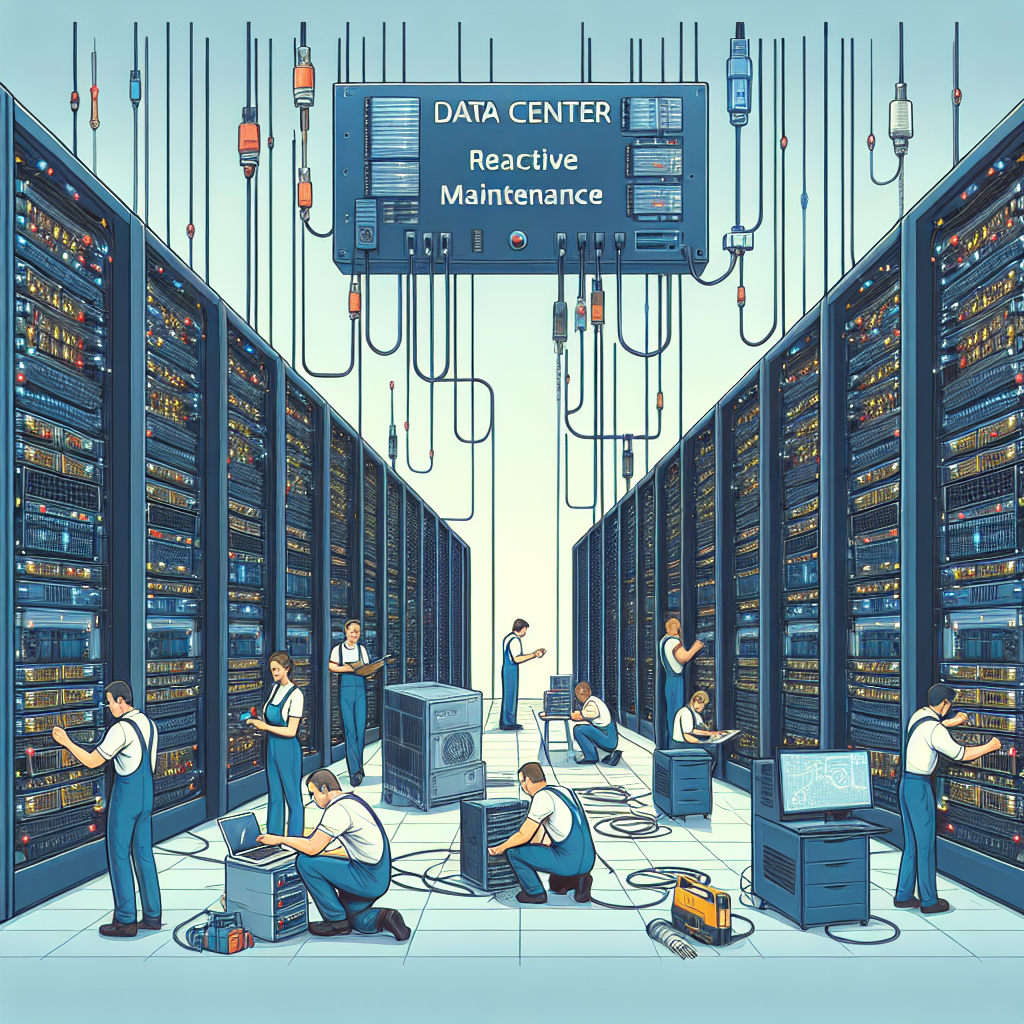
Ensuring Operational Efficiency: The Benefits of Data Center Reactive Maintenance
In today’s fast-paced digital world, data centers play a crucial role in the operations of businesses of all sizes. These facilities house the servers, networking equipment, and storage systems that store and process massive amounts of data on a daily basis. Ensuring the smooth and efficient operation of a data center is essential for the success of any organization.One key aspect of maintaining the operational efficiency of a data center is implementing a proactive maintenance strategy. This approach involves regularly scheduled inspections and maintenance tasks to prevent potential issues before they occur. While proactive maintenance is important, reactive maintenance also plays a critical role in ensuring the smooth operation of a data center.
Reactive maintenance refers to the practice of addressing issues as they arise, rather than proactively preventing them. While reactive maintenance may not be seen as ideal, there are several benefits to incorporating it into a data center maintenance plan.
First and foremost, reactive maintenance can help minimize downtime. When an issue arises in a data center, it is crucial to address it quickly to prevent disruptions to operations. By addressing issues as they occur, data center operators can minimize downtime and ensure that critical systems remain operational.
Additionally, reactive maintenance can help save time and resources. While proactive maintenance is important for preventing issues, it can be time-consuming and costly. By focusing on addressing issues as they arise, data center operators can prioritize resources and allocate them where they are most needed.
Furthermore, reactive maintenance can help identify underlying issues that may not have been apparent during regular inspections. By addressing issues as they occur, data center operators can gain a better understanding of potential problems and take proactive measures to prevent them in the future.
In conclusion, while proactive maintenance is essential for preventing issues in a data center, reactive maintenance also plays a critical role in ensuring operational efficiency. By addressing issues as they arise, data center operators can minimize downtime, save time and resources, and gain valuable insights into potential problems. By incorporating a combination of proactive and reactive maintenance strategies, organizations can ensure that their data centers operate at peak efficiency.

Mitigating Risks: The Importance of Reactive Maintenance in Data Centers
Data centers are the backbone of modern businesses, housing critical IT infrastructure and valuable data. With the increasing reliance on digital technology, the importance of maintaining data centers has never been more crucial. One key aspect of data center maintenance is reactive maintenance, which involves addressing issues as they arise rather than proactively preventing them.Reactive maintenance plays a vital role in mitigating risks in data centers. By promptly addressing equipment failures, system malfunctions, and other issues, data center operators can minimize downtime and prevent potential data loss. This not only ensures the continued operation of critical IT systems but also protects the business from financial losses and reputational damage.
One of the biggest risks that data centers face is downtime. Even a brief interruption in service can have a significant impact on business operations, leading to lost revenue, unhappy customers, and damage to the company’s reputation. Reactive maintenance helps to reduce the risk of downtime by quickly resolving issues and getting systems back up and running as soon as possible.
Another risk that data centers must contend with is data loss. Whether due to hardware failures, software errors, or cyberattacks, the loss of critical data can have far-reaching consequences for a business. Reactive maintenance can help to mitigate this risk by promptly addressing issues that could potentially lead to data loss and implementing measures to prevent it from happening in the future.
In addition to minimizing downtime and preventing data loss, reactive maintenance also plays a crucial role in ensuring the safety and security of data center operations. By promptly addressing issues such as overheating equipment, electrical faults, and other safety hazards, data center operators can create a safer working environment for employees and protect valuable assets.
While proactive maintenance strategies such as regular inspections, preventive maintenance, and predictive analytics are essential for maintaining data center reliability and efficiency, reactive maintenance is equally important in mitigating risks and ensuring the continued operation of critical IT infrastructure. By promptly addressing issues as they arise, data center operators can minimize downtime, prevent data loss, and enhance the safety and security of their operations.
In conclusion, reactive maintenance is a key component of data center maintenance that helps to mitigate risks and ensure the continued operation of critical IT infrastructure. By promptly addressing issues as they arise, data center operators can minimize downtime, prevent data loss, and enhance the safety and security of their operations. As businesses continue to rely on digital technology, the importance of reactive maintenance in data centers will only continue to grow.

Predicting the Unpredictable: The Value of Reactive Maintenance in Data Centers
In the fast-paced world of data centers, downtime can be detrimental to both business operations and customer satisfaction. As a result, data center managers are constantly seeking ways to predict and prevent potential issues before they occur. However, despite their best efforts, some maintenance issues are simply unpredictable.This is where reactive maintenance comes into play. Reactive maintenance, also known as run-to-failure maintenance, involves addressing issues as they arise rather than proactively trying to prevent them. While this approach may seem counterintuitive, there are actually several benefits to using reactive maintenance in data centers.
First and foremost, reactive maintenance can be more cost-effective than preventative maintenance in some cases. By only addressing issues when they occur, data center managers can avoid wasting resources on unnecessary maintenance tasks. This can help to optimize the use of resources and ensure that maintenance budgets are used efficiently.
Additionally, reactive maintenance can help data center managers to better prioritize maintenance tasks. By focusing on the most critical issues as they arise, managers can ensure that downtime is minimized and that the most important aspects of the data center are functioning properly. This can help to improve overall data center performance and reliability.
Furthermore, reactive maintenance can also help data center managers to adapt to changing conditions more effectively. In a constantly evolving industry, it can be difficult to predict future maintenance needs. By using a reactive approach, managers can respond quickly to unforeseen issues and make adjustments as needed.
Of course, it is important to note that reactive maintenance should not be used as a replacement for preventative maintenance. While reactive maintenance can be beneficial in certain situations, it is still important for data center managers to implement a comprehensive maintenance strategy that includes both reactive and preventative measures.
In conclusion, while predicting the unpredictable may be a challenge in data centers, reactive maintenance can offer a valuable solution. By addressing issues as they arise and adapting to changing conditions, data center managers can better optimize resources, prioritize tasks, and improve overall performance. Ultimately, the value of reactive maintenance lies in its ability to help data centers stay agile and responsive in a dynamic environment.
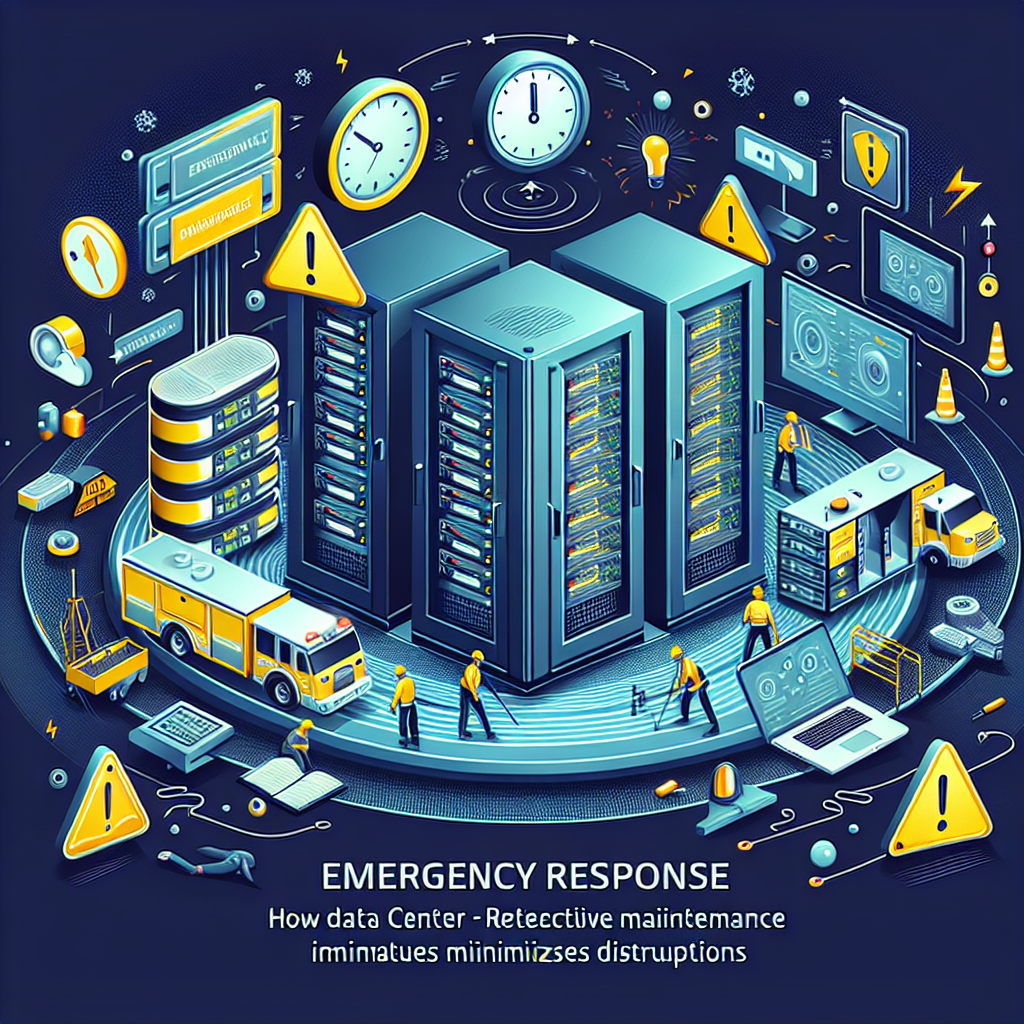
Emergency Response: How Data Center Reactive Maintenance Minimizes Disruptions
In today’s digital age, data centers play a crucial role in ensuring the smooth operation of businesses and organizations. These facilities house the servers and networking equipment that store and process large amounts of data, making them vital to the functioning of modern enterprises. However, like any other complex system, data centers are prone to malfunctions and disruptions that can have serious consequences for the businesses that rely on them.One of the key challenges that data center operators face is the need to respond quickly and effectively to emergencies that can arise at any time. Whether it’s a power outage, a cooling system failure, or a cyber-attack, downtime in a data center can lead to significant financial losses and damage to a company’s reputation. This is why proactive maintenance and emergency response procedures are essential to minimizing disruptions and ensuring the continued operation of a data center.
Reactive maintenance is a critical component of emergency response in data centers. This approach involves addressing issues as they arise, rather than waiting for them to become more serious and potentially causing a major disruption. By having a team of skilled technicians on standby to respond to emergencies, data center operators can quickly identify and resolve problems before they escalate.
One of the key benefits of reactive maintenance is its ability to minimize downtime in a data center. When an emergency occurs, every minute counts, and having a team of experts available to address the issue can significantly reduce the time it takes to get the facility back up and running. This can save businesses valuable time and money, as well as prevent potential data loss or security breaches.
In addition to minimizing downtime, reactive maintenance can also help data center operators identify and address underlying issues that may be contributing to emergencies. By conducting thorough inspections and diagnostics during emergency response, technicians can pinpoint the root cause of a problem and implement long-term solutions to prevent it from happening again in the future.
Furthermore, reactive maintenance can also help data center operators comply with industry regulations and standards. Many regulatory bodies require data centers to have emergency response plans in place to ensure the safety and security of the facility and the data it houses. By implementing a proactive maintenance program that includes emergency response procedures, data center operators can demonstrate their commitment to compliance and ensure that they are prepared for any eventuality.
In conclusion, emergency response is a critical aspect of maintaining the smooth operation of a data center. By implementing a proactive maintenance program that includes reactive maintenance procedures, data center operators can minimize disruptions, reduce downtime, and ensure the continued functioning of their facilities. With the increasing reliance on data centers for business operations, investing in emergency response capabilities is essential for safeguarding the integrity of critical data and systems.

Best Practices for Implementing Data Center Reactive Maintenance Strategies
In today’s fast-paced digital world, data centers play a crucial role in ensuring the smooth operation of businesses. With the increasing reliance on data and technology, it is essential for companies to have a robust maintenance strategy in place to prevent downtime and ensure optimal performance.One key aspect of data center maintenance is reactive maintenance, which involves addressing issues as they arise rather than following a predetermined schedule. While proactive maintenance is important for preventing problems before they occur, reactive maintenance is necessary for handling unexpected issues that may arise.
Here are some best practices for implementing data center reactive maintenance strategies:
1. Monitor and Analyze Performance Metrics: One of the first steps in implementing a reactive maintenance strategy is to monitor and analyze key performance metrics. By tracking metrics such as temperature, humidity, power usage, and network traffic, data center operators can identify potential issues before they escalate into major problems.
2. Establish Clear Communication Channels: Communication is key when it comes to reactive maintenance. It is important to establish clear communication channels between data center staff, vendors, and other stakeholders to ensure that issues are addressed promptly and efficiently.
3. Prioritize Critical Systems: Not all systems in a data center are created equal. It is important to prioritize critical systems and equipment to ensure that they receive timely attention in the event of an issue. By categorizing systems based on their importance to the business, data center operators can focus their resources on addressing the most critical issues first.
4. Implement Remote Monitoring and Management Tools: Remote monitoring and management tools can help data center operators detect and diagnose issues in real-time, allowing them to respond quickly and effectively to minimize downtime. These tools can also provide valuable insights into the performance of the data center, helping operators make informed decisions about maintenance and upgrades.
5. Develop a Comprehensive Incident Response Plan: In the event of a major issue, it is important to have a comprehensive incident response plan in place. This plan should outline the steps to be taken in the event of an emergency, including who to contact, how to escalate issues, and how to restore operations as quickly as possible.
6. Regularly Review and Update Maintenance Procedures: Data center environments are constantly evolving, and maintenance procedures should be regularly reviewed and updated to reflect changes in technology, equipment, and best practices. By staying current with industry trends and standards, data center operators can ensure that their reactive maintenance strategies remain effective and efficient.
In conclusion, implementing a proactive maintenance strategy is essential for preventing downtime and ensuring the optimal performance of data center operations. By following these best practices for implementing reactive maintenance strategies, data center operators can effectively address issues as they arise and minimize the impact of unexpected downtime on their business operations.
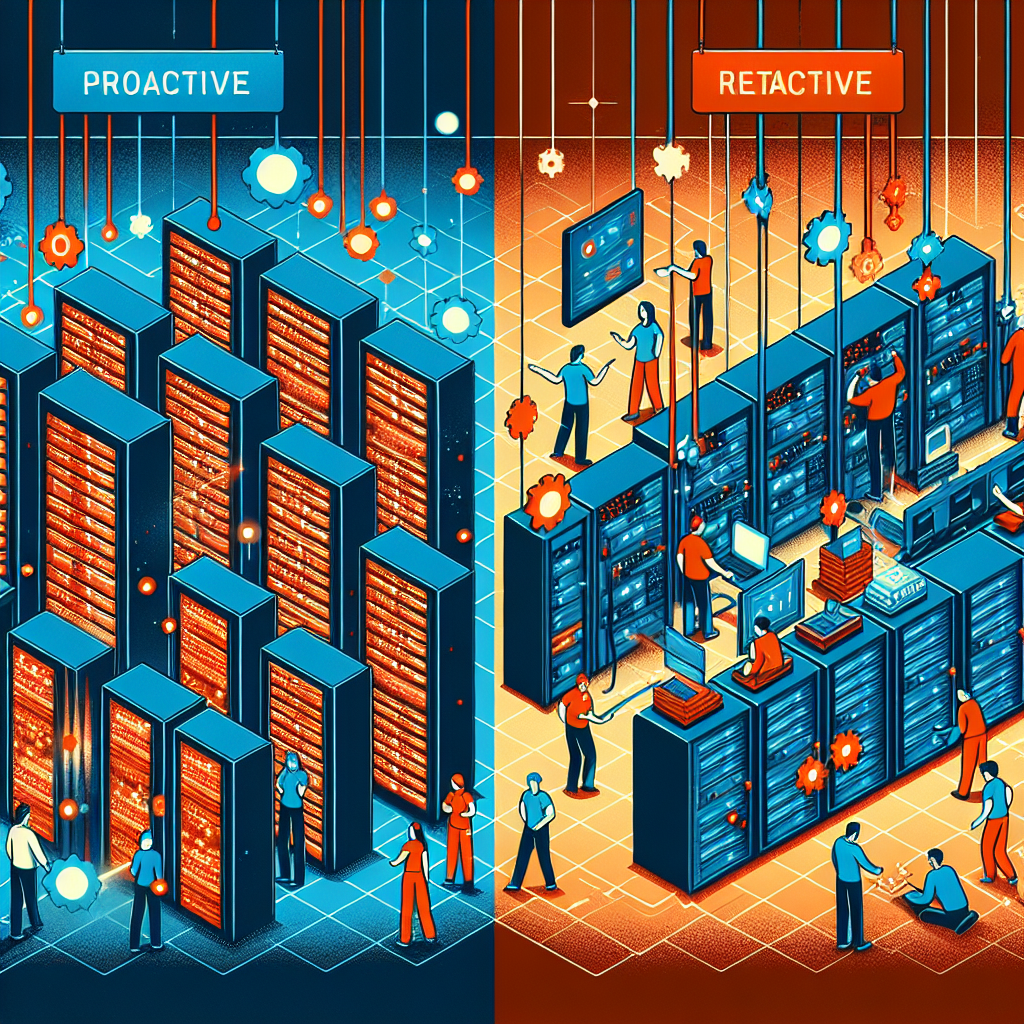
Proactive vs. Reactive: The Benefits of Data Center Reactive Maintenance
Data centers are crucial for the functioning of many businesses and organizations, as they house the servers and equipment that allow for the storage and processing of data. With the increasing reliance on technology and data, it is essential for data centers to be properly maintained to ensure optimal performance and prevent downtime.When it comes to maintaining a data center, there are two main approaches: proactive maintenance and reactive maintenance. Proactive maintenance involves regularly scheduled inspections, testing, and preventive measures to identify and address potential issues before they escalate. On the other hand, reactive maintenance involves addressing issues as they arise, often in response to equipment failures or malfunctions.
While proactive maintenance is generally considered the ideal approach, reactive maintenance also has its benefits, especially when it comes to data center operations. Here are some of the benefits of data center reactive maintenance:
1. Cost-effective: Reactive maintenance can be more cost-effective in some cases, as it involves addressing issues only when they occur, rather than investing in regular preventive measures. This can be particularly beneficial for organizations with limited resources or budget constraints.
2. Flexibility: Reactive maintenance allows for more flexibility in scheduling maintenance activities, as they can be carried out as needed rather than on a strict timetable. This can be advantageous for data centers that have fluctuating workloads or operational demands.
3. Minimizing downtime: While proactive maintenance aims to prevent downtime by addressing potential issues before they occur, reactive maintenance can also help minimize downtime by quickly resolving issues as they arise. This can be crucial for organizations that rely on their data centers for critical operations.
4. Quick resolution: Reactive maintenance allows for quick resolution of issues, as technicians can respond promptly to equipment failures or malfunctions. This can help prevent further damage and minimize the impact on data center operations.
5. Focus on critical issues: Reactive maintenance allows for a focus on critical issues that require immediate attention, rather than spending resources on preventive measures that may not be necessary. This can help ensure that the most pressing issues are addressed promptly and effectively.
While proactive maintenance is generally considered the best approach for data center maintenance, reactive maintenance also has its benefits, especially when it comes to addressing issues quickly and efficiently. By combining proactive and reactive maintenance strategies, data center operators can ensure optimal performance and reliability while minimizing downtime and costs.
